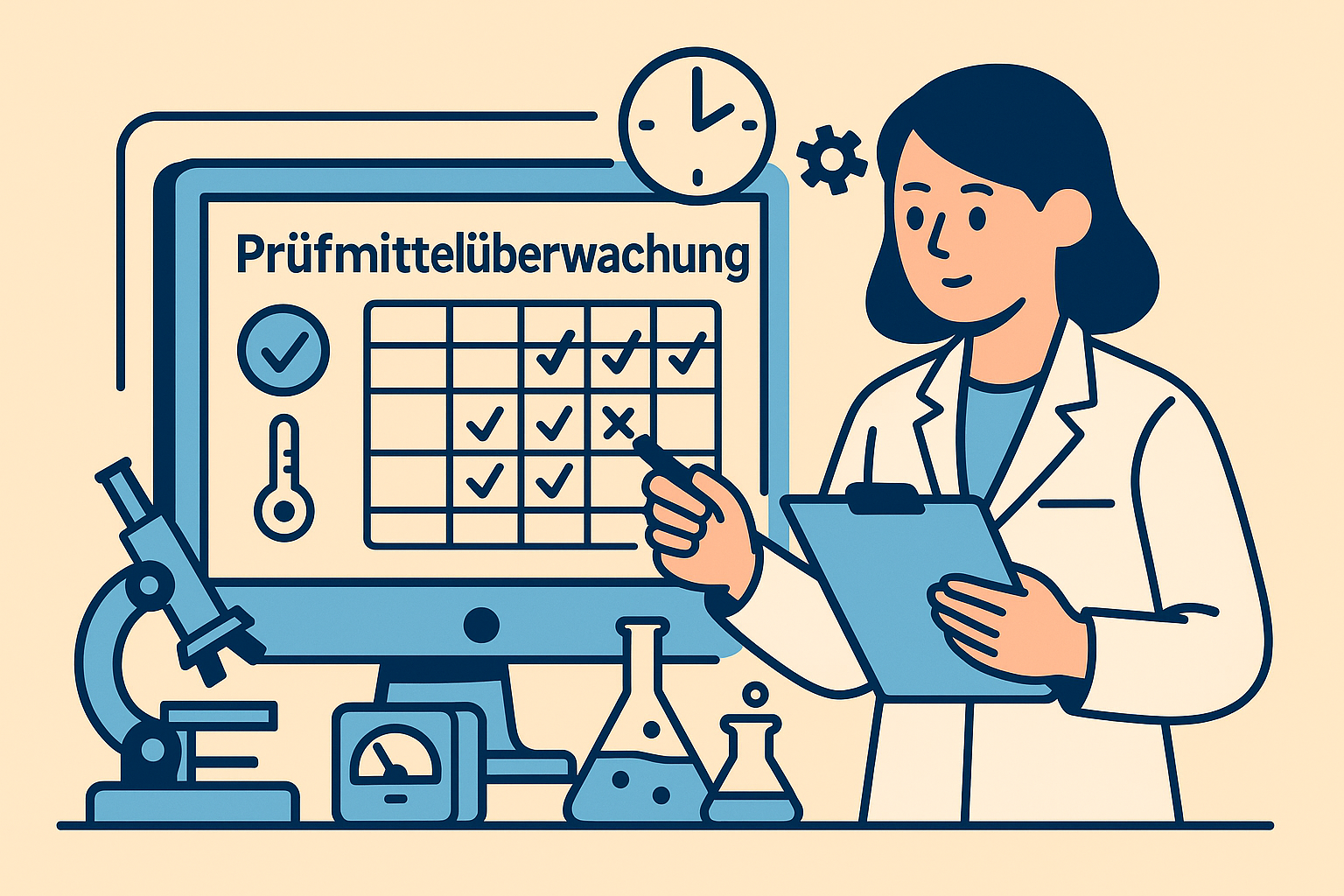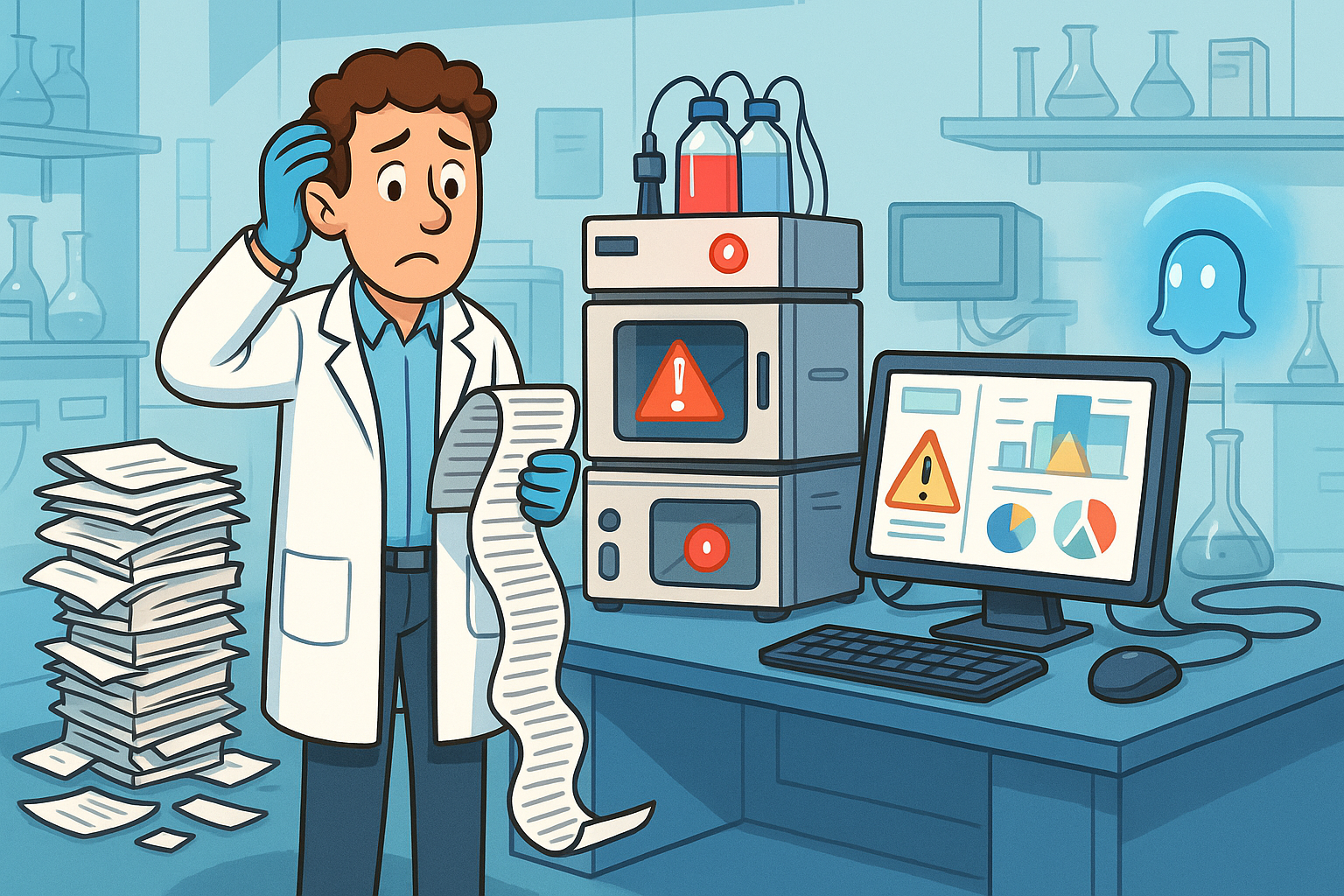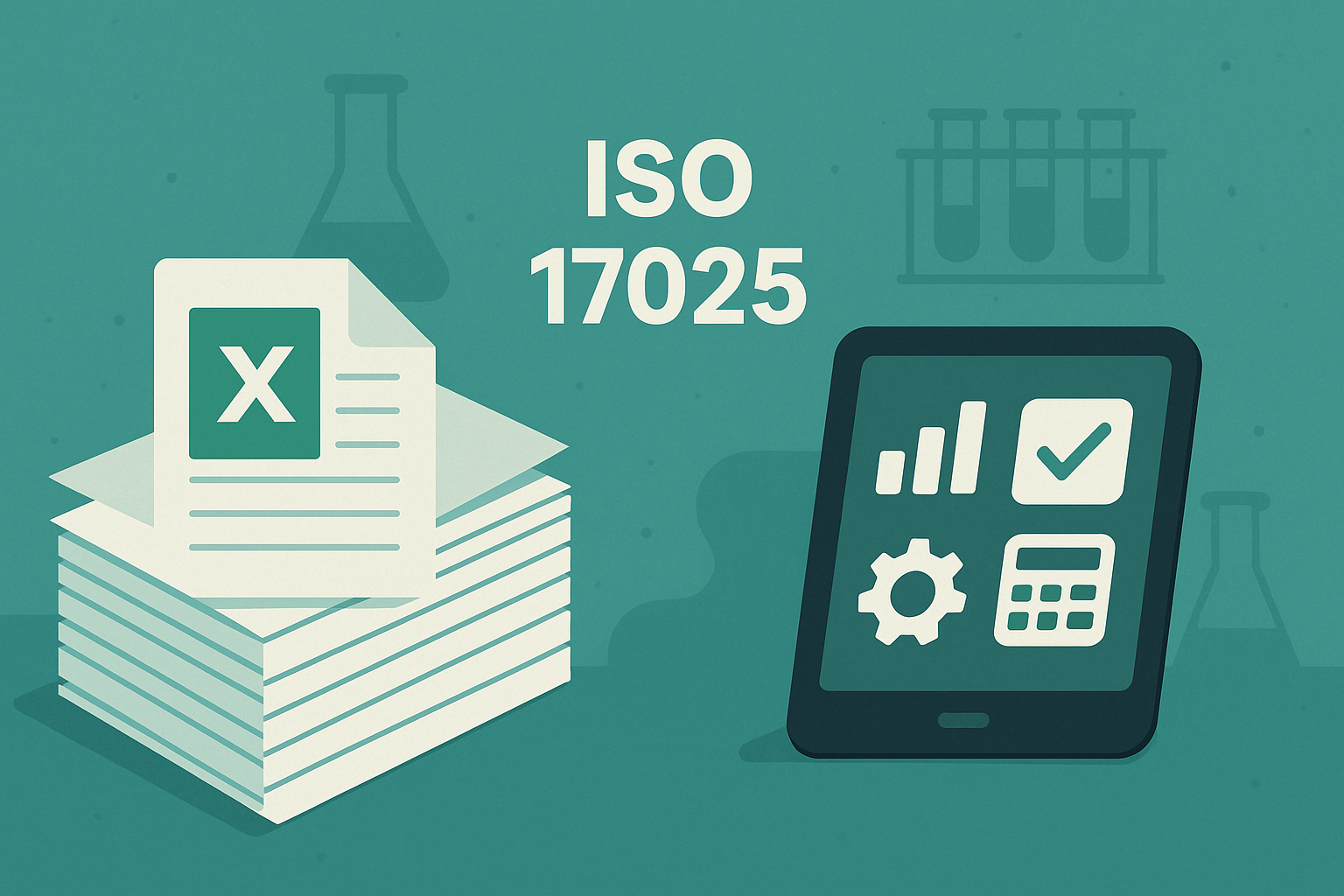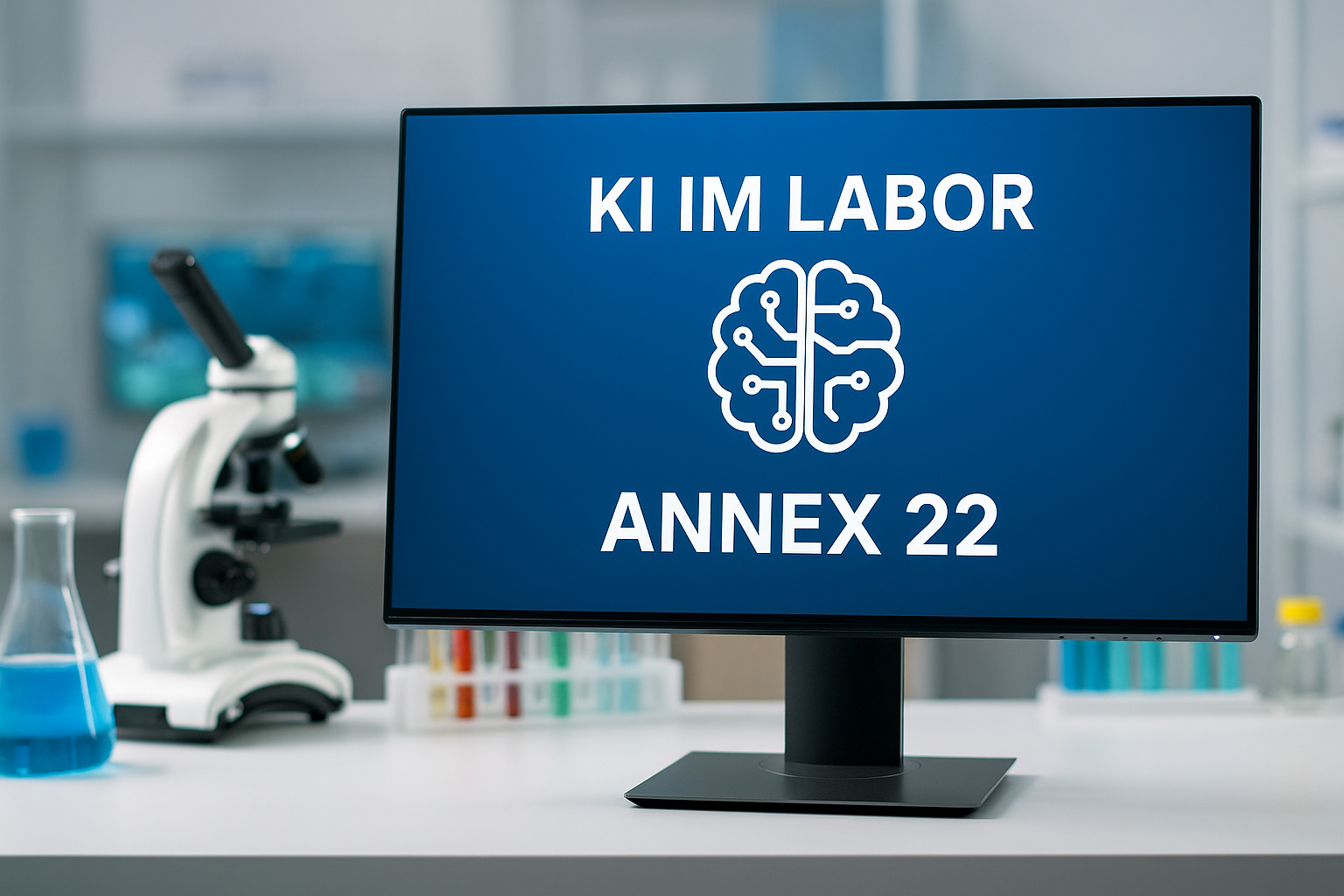The future of laboratory automation starts now
Laboratory automation is no longer a dream of the future - it is already changing the way laboratories work. While fully autonomous "dark laboratories", based on the concept of the dark factory, are still under development, there are already numerous technological advances that are making laboratories more efficient, cost-effective and productive. Some of these solutions have long since moved beyond prototype status and are successfully in use in modern laboratories.
But what does laboratory automation mean in concrete terms? Essentially, it means replacing repetitive and error-prone processes with smart technology - from pipetting robots to highly complex analysis systems that can independently process samples and evaluate measurement results. AI in the laboratory further expands these possibilities: it not only enables automation, but also intelligent decision-making based on data.
This article is the first in a series on laboratory automation and focuses on the role of hardware. We show which devices are already optimizing processes today, how they contribute to increasing efficiency and accuracy and which technologies will prevail in the future.
But laboratory automation is more than just technology - it requires a well thought-out strategy. In the following sections, we not only look at existing automation options, but also at two strategies for successful implementation: step-by-step automation and full automation from the outset.
Laboratory automation today: which technologies are already in use
Even today, automated laboratory equipment offers enormous opportunities to make work processes more efficient and optimize routine tasks. Automated systems are already established in many areas and help to improve accuracy, reduce workload and make better use of laboratory capacity. Therefore, laboratory automation and modern technologies should be considered in any laboratory that is looking for long-term efficiency.
Choosing the right hardware is a decisive factor here. Analytical devices, pipetting robots and fully automated sample preparation systems already take over many work steps and enable seamless process optimization in the laboratory. In addition to pure functionality, user-friendliness, ease of maintenance and the ability to integrate into existing systems are also crucial in order to exploit the full potential of these technologies.

The following automation options are already an integral part of many laboratories and show what is already possible in laboratory automation:
- Liquid handling and sample preparation robots: These devices specialize in automating accurate and repeatable pipetting and complete sample preparation steps. A leading company in the automation of complete laboratory workstations is Axel-Semrau GmbH (by Trajan) from Sprockhövel. Axel Semrau specializes in the fully automated execution of entire analytical tasks, which often include routine analyses such as FAME, MOSH MOAH, PAH or glyphosate. The use of such systems enables laboratories to save considerable capacity and significantly increase efficiency.
- Automated analysis systems: HPLC (MS) and GC (MS) devices represent the gold standard in many laboratories and are equipped with numerous smart features that partially automate analysis. For example, some of these HPLC models offer the option of performing derivatization steps or standard dilutions directly in the autosampler. These functions allow complex analyses to be carried out automatically, which not only significantly reduces the time required for data collection, but also allows labor to be used more efficiently. This automation greatly increases the accuracy of results and leads to significant savings in time and labor. Typical manufacturers of high quality HPLC models include Shimadzu Corporation, Agilent Technologies and Thermo Fisher
- Dissolution testers in pharmaceutical research and quality control: In pharmaceutical research and development as well as in quality control, automated dissolution testers are crucial for increasing efficiency and optimizing work processes. These devices, which are often directly coupled to an HPLC (High-Performance Liquid Chromatography) or UV spectrometer, automate the analysis of drug release from pharmaceutical formulations. This direct coupling eliminates the need for manual sample preparation by laboratory technicians, saving a significant amount of time. Every step that would have required manual pipetting into individual vials is automated, saving valuable working time and speeding up the analysis process. Leading manufacturers such as Sotax, offer state of the art solutions designed to not only improve the accuracy of testing, but also significantly reduce the overall turnaround time in sample preparation and analysis. These systems are essential for the efficient performance of routine analyses and ensure that quality control is carried out efficiently in compliance with regulatory standards.
In addition to frequently used and standardized hardware, there are increasing trends towards complete automation. These developments include
- Robotics and automated sample transport systems: Robotics and automated sample transport systems are becoming increasingly important in modern laboratories. These technologies, which are used for handling and transporting samples between different analysis stations, will be indispensable in the laboratories of the future. They automate critical processes, reduce the need for manual intervention and shorten turnaround times, helping to increase efficiency and accuracy while minimizing the potential for error. To be fair, it must be mentioned here that such extensive automation projects are usually always custom-made.
A glimpse into the future: In specific analytical areas, comprehensive sample preparation systems play a decisive role. These sophisticated systems not only perform standard tasks such as pipetting, but also integrate centrifugation and derivatization functions. By automating and optimizing the sample preparation process, they contribute significantly to increasing the efficiency and accuracy of subsequent analyses. Although these systems cannot be integrated as easily as an HPLC due to their complexity, they are nevertheless beginning to establish themselves on the market. It is very likely that such systems will take over much of the routine work in the laboratory in the future, as they can replace human labor in many areas.
Laboratory automation: mastering challenges, exploiting benefits
The automation of a laboratory is a complex project that involves considerable preparation, high costs and technical conversion. In addition, it often requires a restructuring of work processes, which means a major adjustment for laboratory staff. For these reasons, many laboratories are reluctant to implement automation projects, even though the long-term benefits can be enormous.
In this section, we highlight the key benefits of laboratory automation and show the concrete benefits that automated systems offer in terms of efficiency, accuracy and resource optimization. We also present two strategic approaches that can be used to automate laboratories in a targeted and efficient manner without unnecessarily disrupting operations or wasting resources.

Many laboratories do not fully utilize the automation possibilities of their existing equipment pool. Modern HPLC autosamplers often already have powerful functions such as automatic dilutions, co-injection and integrated derivatization steps. Ask your manufacturer for advice on which automation options your current equipment already offers - optimization is often possible without having to make new investments.
The most important advantages of laboratory automation
Automation in the laboratory brings many advantages that make everyday work much easier. Even if the changeover initially involves effort, the investment pays off in the long term - both financially and in terms of efficiency and quality. Clever automation of processes not only saves time and resources, but also improves accuracy and safety in the laboratory.
Here is an overview of the main advantages:
1️⃣ More productivity & time savings
Every manual work step costs time - and time is one of the most valuable resources in the laboratory. Automation in the laboratory means that recurring tasks such as pipetting, sample handling or analyses run automatically.
✅ Relieve employees: Instead of performing routine tasks, the team can focus on more demanding analyses and research.
✅ Faster processes: High-throughput procedures can be automated so that samples can be processed around the clock.
✅ Reduced waiting times: Processes run seamlessly and without delays - machines don't have to wait for breaks or shift changes.
2️⃣ Higher accuracy & reproducibility
Manual processes always harbor the risk of human error - be it through lack of concentration, minor inaccuracies or varying working methods between different employees.
✅ Error minimization: Automated devices work according to precisely defined parameters and deliver consistent results.
✅ Better data quality: Measured values are more consistent, which is particularly important for quality control and scientific research.
✅ Standardized processes: All samples are treated identically, which ensures comparability of results.
3️⃣ Efficient use of resources & cost savings
Automation helps to deploy resources in a targeted manner and avoid unnecessary costs.
✅ Less material wastage: More precise dosing ensures that reagents are used optimally.
✅ Reduced personnel costs: Instead of performing repetitive tasks manually, specialists can concentrate on value-adding activities.
✅ Better equipment utilization: Automated systems can also be operated outside regular working hours.
4️⃣ More safety for staff & samples
Many laboratories work with potentially hazardous chemicals or biological samples. Laboratory automation can help to reduce the risk to employees.
✅ Less contact with hazardous substances: Automated systems take over work with toxic substances so that personnel are less exposed.
✅ Reduced risk of contamination: machines work under standardized conditions and avoid cross-contamination.
✅ Safe sample storage & transport: fully automated systems take over the transport and archiving of samples.
5️⃣ Scalability & future-proofing
The requirements in laboratories are increasing - be it due to more samples, stricter regulations or new analysis methods. Automation makes it possible to remain flexible and prepare for the future.
✅ Scalable: Automated systems can be easily expanded as the number of samples increases.
✅ Competitive advantage: Laboratories that rely on automation in the laboratory at an early stage are more efficient and competitive in the long term.
The challenges of laboratory automation
Laboratory automation offers enormous benefits, but it is not without its challenges. Many laboratories are reluctant to implement it, as the switch to automated systems not only means a financial investment, but also requires far-reaching changes in work processes.
Here are some of the biggest challenges labs face on the road to automation:
High initial investment
The purchase of automated laboratory equipment often requires a significant capital investment. In addition to the equipment costs, training, maintenance and integration into existing systems must also be taken into account. Smaller laboratories in particular are faced with the question of how they can implement automation in an economically viable way without breaking the budget.
Gradual automation can help to spread investments and minimize risks. Instead of converting the entire laboratory at once, it is worth starting with individual, particularly time-consuming or error-prone processes.
Complexity of integration into existing systems
Many laboratories work with different analysis methods and manufacturer systems that are often not directly compatible with each other. Data formats, control protocols and interfaces can vary greatly, making it difficult to seamlessly integrate new automation solutions.
Modular systems and standardized interfaces, such as LIMS-compatible devices, facilitate networking and ensure better scalability. Anyone opting for new technologies should ensure that they can be integrated into existing structures and do not lead to isolated individual solutions.
Acceptance and changeover in the team
Automation not only changes processes, but also the demands placed on staff. Some employees fear that automation will replace their work, while others will have to adapt to new systems that they may not be able to master immediately. In addition, an incorrect introduction can reduce efficiency at the beginning if processes are not yet optimally established.
Early involvement of the team, targeted training and clear communication help to reduce uncertainty and promote acceptance. Automation should not replace staff, but rather relieve them by taking over routine tasks and creating capacity for more demanding activities.
Maintenance and reliability
Automated systems are powerful, but they require regular maintenance and can disrupt the entire workflow in the event of a failure. A single defect can have far-reaching consequences if no emergency plan is in place.
Predictive maintenance with AI-supported error analysis can minimize failures by detecting problems early on before they lead to major disruptions. In addition, laboratories should always have backup strategies for critical processes ready so that they can react flexibly in an emergency.
Scalability and future-proofing
Automation solutions must be future-proof. What works perfectly today could be outdated in a few years due to new standards or technologies. If you commit to proprietary or non-expandable systems too early, you could lose flexibility in the long term.
Modular and cloud-based solutions offer greater adaptability and are easier to expand. In the long term, the integration of AI can help to adapt new developments more quickly and continuously improve automation solutions.
Particularly critical aspects of comprehensive laboratory automation
A particularly challenging aspect of complete laboratory automation is the automated sample movement - i.e. the entire process chain from sample preparation and transfer to the respective sample container to the autosampler of the corresponding analysis system.
In many routine laboratories, sample preparation differs depending on the device and analysis method, which currently makes a standardized, fully automated solution difficult. Currently, every laboratory automation system would have to rely on standardized sample containers, defined volumes and uniform sample handling protocols in order to enable end-to-end automation.
Another problem: the gradual loss of knowledge
As automation increases, so do the requirements for technical understanding and system maintenance. The more complex laboratory processes become, the more essential it is that knowledge is recorded in a structured manner and remains available in the long term. But this is precisely one of the biggest challenges facing modern laboratories: Valuable know-how is lost, be it through the departure of experienced specialists, a lack of documentation or inadequately structured handovers.
This is a recurring problem, especially in highly specialized laboratories. There is often no centralized knowledge management and important information is passed on verbally or via unofficial channels. As a result, critical system configurations, maintenance cycles or troubleshooting measures are only known to a few employees. If one of these experts leaves the company, gaps are left behind that have to be painstakingly filled.
Missing documentation means:
📌 Longer induction periods for new or changing employees
📌 Increased susceptibility to errors, as specific system knowledge is not systematically passed on
📌 Inefficient maintenance, which is made more difficult by unclear specifications and a lack of protocols
📌 Dependence on individual experts, which means that critical knowledge is not widely available
One solution is offered by modern equipment management systems such as LabThunderwhich automatically maintain all technical logbooks, document maintenance processes and enable seamless traceability. These systems not only help laboratories to analyze errors more quickly, but also to safeguard the team's experience in the long term.
Why is this so important?
🔹 Automated systems require regular maintenance - without in-depth knowledge, the risk of unplanned downtime increases
🔹 Laboratory processes and systems are constantly changing - flexible, digitalized knowledge ensures continuous optimization
🔹 New employees or changing teams can be trained more quickly without losing valuable time
In the future, no automated laboratory will be able to avoid this issue. Sustainable digitalization of knowledge management is just as crucial as the automation of physical laboratory processes. Only those who manage technology and expertise in equal measure will remain competitive in the long term.
Conclusion: The future of laboratory automation is now
Conclusion: The future of laboratory automation is now
Automation in the laboratory is no longer a vision of the future - it is a reality and is developing rapidly. Modern technologies enable laboratories to work more efficiently, reduce costs and minimize sources of error. Especially in routine processes, automation offers a clear advantage by taking over recurring tasks, increasing productivity and improving the quality of results.
However, the path to automation requires strategic planning. High initial investments, integration challenges and acceptance within the team are key hurdles that need to be overcome. While gradual automation relieves the burden on laboratories and makes them adaptable, complete replanning can ensure maximum efficiency in the long term. The choice of the right strategy depends on the individual requirements of the laboratory.
One crucial factor that is often overlooked is the availability of knowledge. As automation increases, so does the need for technical expertise to maintain and make optimum use of the systems. Insufficient documentation and a lack of knowledge management can slow down the progress of automation. Solutions such as digital equipment management systems like LabThunder help to preserve valuable specialist knowledge and make it accessible to all employees.
Automation is more than just technology - it is a change in the laboratory world. Laboratories that rely on smart systems at an early stage and systematically digitize their knowledge not only secure competitive advantages, but also actively shape the future of laboratory work.
🔍 What steps are you planning for your laboratory?
Contact us - we will help you find the optimum automation strategy!


LabThunder:
✅ Digital logbooks instead of paper chaos
✅ Thunder AI - central intelligence for faults & questions
✅ Smart & predictive maintenance prevents breakdowns
✅ More independence from external service
✅ Up to 50% fewer service calls
✅ Easy to use - no IT required
Contact us today for a free demo:













.jpg)
.jpg)

